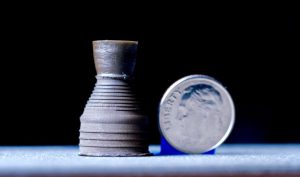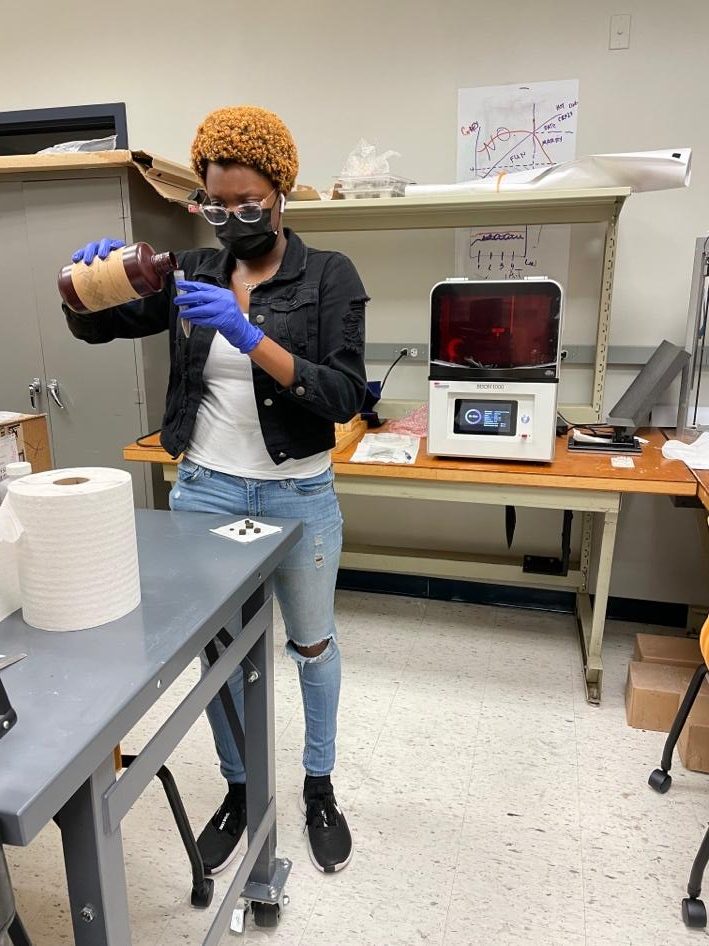[et_pb_section fb_built=”1″ admin_label=”section” _builder_version=”3.22″ custom_padding=”|961px||||” global_colors_info=”{}”][et_pb_row admin_label=”row” _builder_version=”3.25″ background_size=”initial” background_position=”top_left” background_repeat=”repeat” custom_margin=”|auto|-14px|auto||” global_colors_info=”{}”][et_pb_column type=”4_4″ _builder_version=”3.25″ custom_padding=”|||” global_colors_info=”{}” custom_padding__hover=”|||”][et_pb_text _builder_version=”4.14.2″ _module_preset=”default” background_color=”#e0e0e0″ hover_enabled=”0″ global_colors_info=”{}” sticky_enabled=”0″]
Project Title: Developing 3D-printable Ultra High Temperature Ceramic Composite
Participant: Ms. Cameron Drewery
Cameron Drewery was part of 10-weeks summer research experience program here at FIU, Plasma Forming Lab. They were involved in developing or understanding the feasibility of whether a space grade material like tantalum carbide (TaC), which is an ultra-high temperature ceramic (UHTC) can be 3D printed. TaC is a refractive material with a melting point of 3880oC. TaC can withstand extremely harsh operating conditions. And hence TaC could be used in thermal protection systems in supersonic vehicles or as some functional parts in super-heated nuclear reactors. As we all know, due to lack of plasticity, ceramic cannot be machined. Hence near net shape manufacture of ceramic parts have been currently focused via 3D printing techniques.
Using Digital Light Processing (DLP) 3D printing technique, Cameron and Mabel did an extensive study on the formulation of 3D printable TaC resin. The research involved understanding the UV absorption behavior of the TaC resin, optimizing the printing parameters such as UV light intensity, exposure time and printing a prototype to attest the success. Several formulations of the TaC r resin were studied and eventually it was found that the resin with 20 vol%. TaC yielded the best result. The maximum layer thickness achieved with this resin was ~ 25 um at 50% of the equipment’s’ UV intensity. Higher intensity over-cured the TaC resin, manifesting into cracks and delamination. Figure below shows a scaled down TaC rocket nozzle that was printed from the novel TaC resin developed. Further studies involve designing the heat treatment to obtain pure ceramic parts with minimum to no porosities.


Project Title: Effect of Carbon fiber reinforcement on the processing and mechanical properties of High-Entropy Ultra-High
Participant: Mr. Nathan Gillespie
During the REU summer program 2021, Nathan Gillespie, an undergraduate at Missouri University of Science and Technology was mentored. He worked on improving the hardness and fracture toughness of multi-component ultra-High temperature ceramics (MC- UHTCs). The formation of single-phase solid solutioning in Mc-UHTCs has been attributed to the enhanced hardness when compared to traditional UHTCs. (Ta,Nb,Hf,Ti)C was batched and reached a relative density of over 99% via spark-plasma sintering. Vickers microindentation yielded a hardness value of 24 ± 2 GPa and a fracture toughness value of 3.8 ± 0.7 MPa∙m1/2.

Summer 2020
PRE-CCAP Remote Research Experiences for Undergraduates
1. Ms. Bhairavi Chandersekhar – Electronic & Oxidation Properties of Ultra High Temperature Ceramics (UHTC)
2. Mr. Pedro Mireles – Additive Manufacturing of Novel Engineering Ceramics by Photolithography Technique
[/et_pb_text][/et_pb_column][/et_pb_row][/et_pb_section]
